Mortuary Temple of Hatshepsut
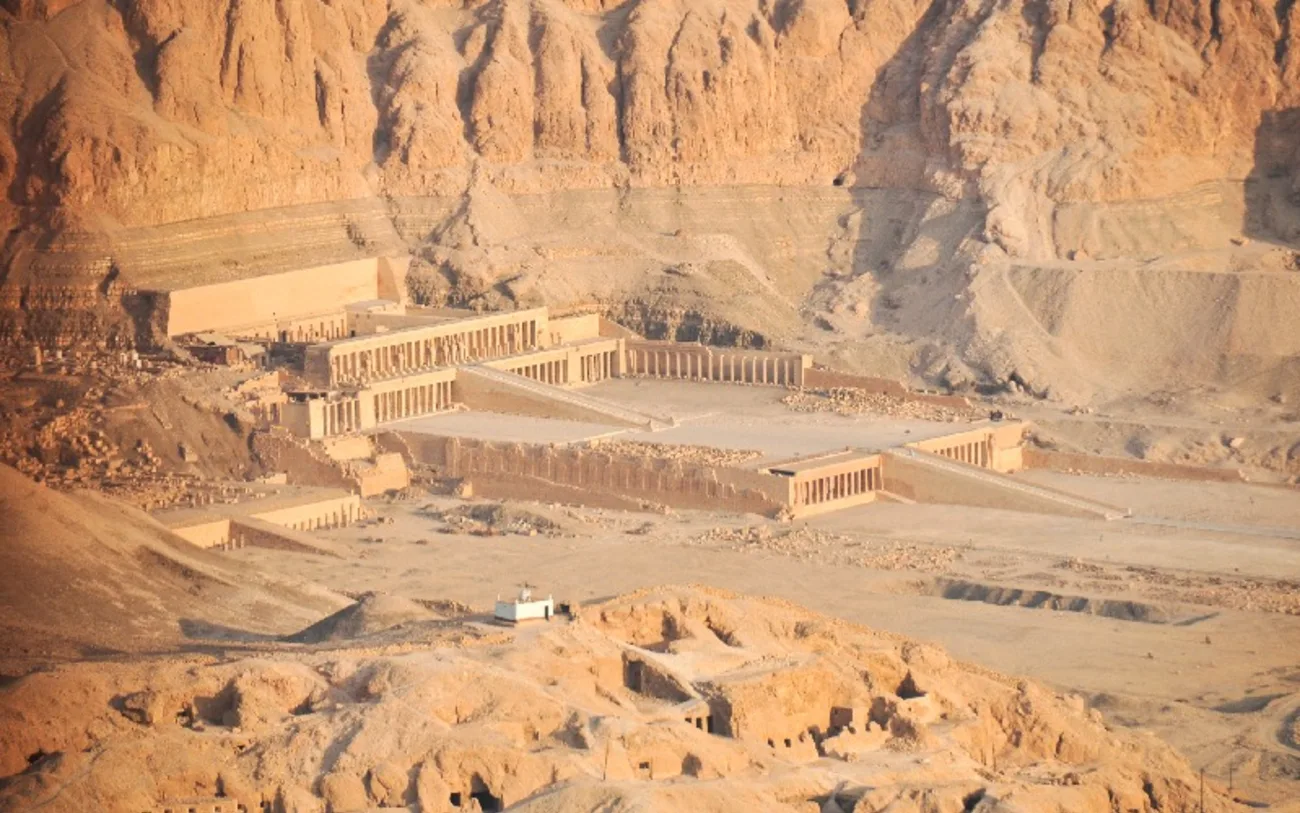
The temple of Hatshepsut stands as a masterpiece of ancient architecture, blending almost seamlessly with the surrounding cliffs from which it is partly cut. Considered one of ancient Egypt's finest monuments, this extraordinary structure features three massive terraces that rise dramatically from the desert floor into the cliffs of Deir el-Bahari.
Located opposite the city of Luxor, the mortuary temple of Hatshepsut (Egyptian: Ḏsr-ḏsrw, meaning "Holy of Holies") was constructed during the reign of Pharaoh Hatshepsut of the Eighteenth Dynasty. Also known as Djeser-Djeseru, Queen Hatshepsut's temple was built over approximately fifteen years, between her seventh and twentieth regnal years (1479-1458 BCE). The temple of Hatshepsut Egypt was designed by her steward and confidante Senenmut, who was also tutor to Neferu-Ra and possibly Hatshepsut's lover. Despite suffering vandalism over centuries—including attempts by Tuthmosis III to remove his stepmother's name and Akhenaten's removal of references to Amun—continuous excavation and restoration since 1891 have revealed the true splendor of this remarkable structure.
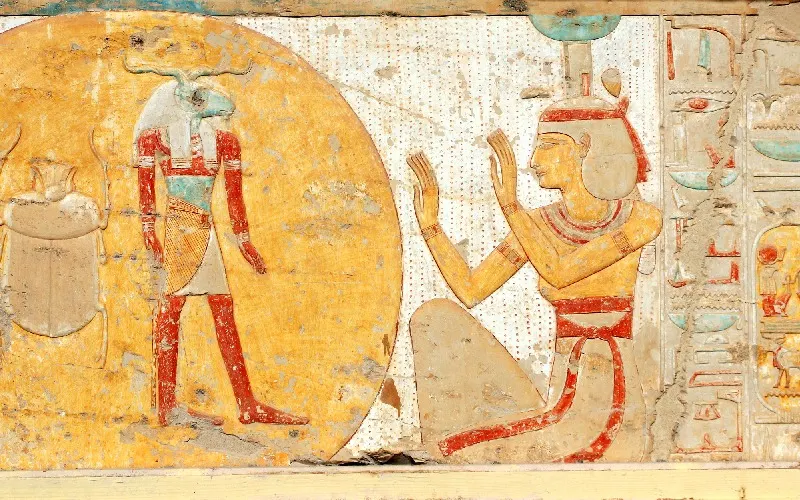
The temple is located at Deir el-Bahari on the west bank of the Nile, directly opposite modern-day Luxor. It sits beside other significant monuments, including the mortuary temple of Mentuhotep II.
The Vision Behind the Temple of Hatshepsut
Hatshepsut's rise to power
Hatshepsut, daughter of Thutmose I, ascended to prominence through a methodical consolidation of power. Initially, she married her half-brother Thutmose II, following Egyptian royal tradition to maintain dynastic purity. When Thutmose II died, she became regent for her young stepson, Thutmose III (son of Thutmose II by a lesser wife named Isis). After approximately seven years as regent, she took the unprecedented step of declaring herself pharaoh around 1479 BCE.
To legitimize her rule as a female king—an extraordinary position in ancient Egypt—Hatshepsut adopted the full titles and regalia of a pharaoh, occasionally even wearing a false beard. She further secured her authority by taking a throne name, Maatkare, meaning "Truth is the Soul of the sun god Re," which reinforced her divine right to rule. This period of female leadership coincided with a renaissance in Egyptian history, as gold flowed abundantly into the country.
Purpose of building the mortuary temple
The mortuary temple of Hatshepsut served multiple crucial functions. Primarily, it functioned as a site for royal mortuary cults of both Hatshepsut herself and her father Thutmose I. In these sacred spaces, food and drink offerings were presented before granite false doors of offering chapels for the ka (spirit) of the rulers.
Furthermore, the temple demonstrated Hatshepsut's legitimacy as pharaoh. By building such a magnificent monument, she established her connection to the divine, particularly the god Amun-Ra, whom she honored throughout her reign[72]. The temple's placement beneath the towering cliffs of Deir el-Bahari was deliberately chosen to blend natural landscape with human architecture, symbolizing her connection to both gods and the natural world.
Role of Senenmut in the temple's design
Senenmut, Hatshepsut's chief steward and loyal advisor, was the brilliant architect behind this monumental project. His relationship with the queen was exceptionally close—he served as tutor to her daughter Neferure, managed construction projects across all three Karnak precincts, and enjoyed privileges rarely granted to non-royals, including images of himself adoring the queen in temple reliefs.
Under Senenmut's direction, the temple's design drew inspiration from the neighboring Temple of Mentuhotep II but expanded significantly in scale and grandeur. The construction began around 1479 BCE and took approximately fifteen years to complete, representing an extraordinary achievement for the royal workshops. When Hatshepsut died, however, only the main and essential parts had been finished and decorated, with the temple cult functioning for merely twenty years before Thutmose III ordered the destruction of Hatshepsut's statuary and depictions on the temple walls.
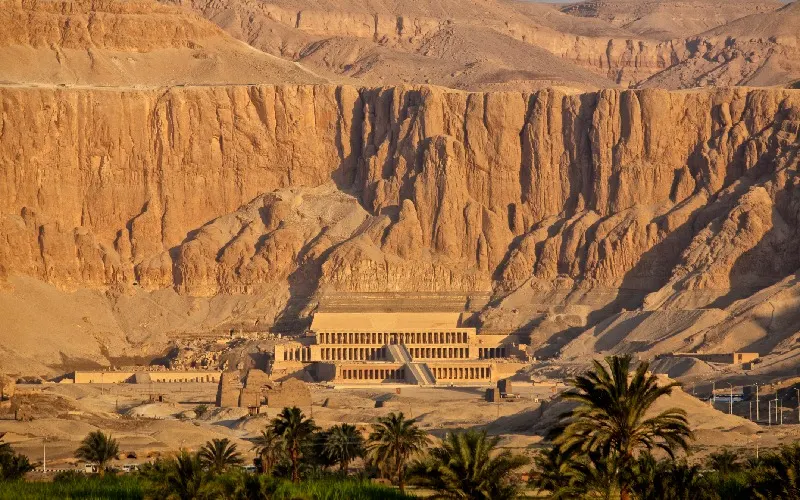
Architectural Design and Layout
Three-tiered terrace structure
Djeser-Djeseru, as Hatshepsut's temple was known, features an innovative three-tiered structure that rises approximately 30 meters (97 feet) from the desert floor. The temple complex spans roughly 150,000 square meters with a façade stretching nearly 150 meters (490 feet) wide. Each of the three magnificent terraces connects via long, ceremonial ramps that create a sense of processional grandeur as visitors ascend. The lowest terrace once featured exotic gardens with trees and shrubs brought from Punt. The middle terrace, accessed by a central ramp, contains elaborately decorated colonnades depicting significant events in Hatshepsut's reign. The uppermost terrace houses the sanctuary dedicated to Amun-Ra, the chief deity of Thebes.
Integration with the cliffs of Deir el-Bahari
Unlike traditional Egyptian temples built on flat terrain, Queen Hatshepsut's mortuary temple ingeniously incorporates the natural landscape as both backdrop and structural support. This strategic integration with the surrounding cliffs emphasizes the temple's sacred nature, symbolically linking it to the mountains as a source of divine power. The design creates a harmonious transition between human-made architecture and natural rock formations, reflecting Hatshepsut's desire to demonstrate her connection to both the gods and the natural world.
Use of limestone, sandstone, and granite
The temple was constructed primarily using limestone quarried from the surrounding cliffs. This abundant material provided durability while creating a striking visual contrast against the reddish sandstone backdrop. Although limestone dominates the structure, certain elements incorporate red granite and sandstone brought from distant quarries. Notably, a single architrave was built of violet sandstone, reportedly sourced from Mentuhotep II's temple.
Influence of Mentuhotep II's temple
Hatshepsut's architectural vision directly referenced the adjacent mortuary temple of Mentuhotep II, who had unified Egypt centuries earlier. Nevertheless, Hatshepsut's design introduced significant innovations, primarily by eliminating the central massif of Mentuhotep's structure, thus creating a wider, more open terrace. This crucial modification enabled direct axial access for the bark of Amun-Re from Karnak, which had been blocked in Mentuhotep's design.
Symbolic alignment with Karnak Temple
The mortuary temple's orientation demonstrates careful astronomical planning. Each year on December 21, the sun aligns perfectly with both Hatshepsut's temple and the Karnak Temple across the Nile. This alignment occurs during a significant celestial event celebrated with popular festivals. The temple's layout was intentionally designed to welcome the divine barque during these ceremonial processions, specifically during the Beautiful Festival of the Valley each May.
Sacred Spaces and Religious Symbolism
At the core of the temple's religious function lies the sanctuary of Amun, situated at the back on the central axis. This sacred chamber, cut directly into the living rock, represented the climactic point of the entire complex. Inside, the first room housed the barque of Amun and featured a skylight illuminating the god's statue. The sanctuary served as the final destination for the annual Beautiful Festival of the Valley, when Amun's statue journeyed from Karnak Temple across the Nile.
On the middle terrace, the Hathor shrine occupies the southern end, accessed by a separate ramp. With its distinctive columns topped by female-faced capitals with cow ears, this shrine honored the goddess associated with femininity and beauty. Correspondingly, the Anubis shrine at the northern end consists of a hypostyle hall with twelve columns followed by two rooms ending in a niche. Both shrines reinforced Hatshepsut's divine connections.
The solar cult court on the upper terrace features a grand altar open to the sky. This courtyard was dedicated to the diurnal journey of the sun, with the limestone altar receiving direct sunlight daily. The complex primarily honored Amun-Re alongside Ra-Horakhty and Atum-Amun—three aspects of the solar deity.
On the temple walls, depictions of Hatshepsut's divine birth show Amun, disguised as her father Thutmose I, visiting her mother Ahmose. These scenes legitimized her rule by establishing her as the god's daughter.
The expedition to Punt reliefs showcase Hatshepsut's successful trade mission that brought exotic goods including myrrh trees, gold, and incense for temple offerings. These valuable imports held special religious significance for rituals.
Temple daily rituals began before dawn with priests collecting water for libation vessels. Other priests prepared food and drink offerings while the head priest underwent purification before conducting ceremonies honoring both gods and royal ancestors.
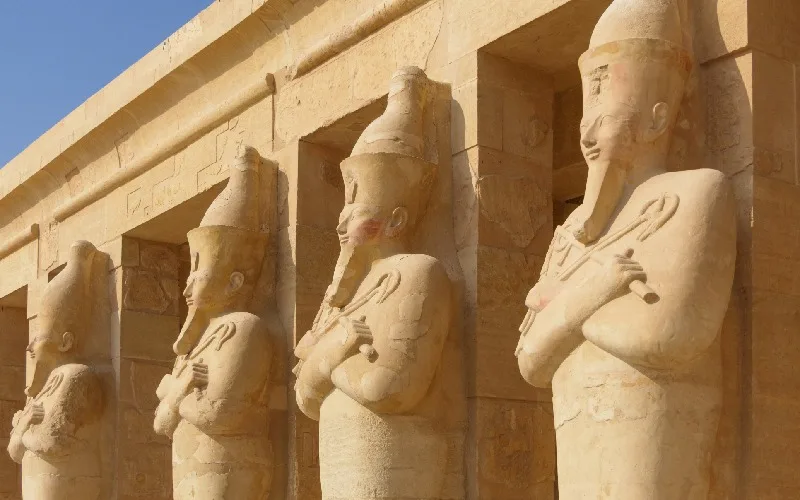
Unlike traditional Egyptian temples with enclosed courtyards, Hatshepsut’s temple features open terraces, long colonnades, and strong horizontal lines that harmonize with the surrounding cliffs, making it one of the most innovative designs in ancient Egyptian architecture.
Customize Your Dream Vacation!
Get in touch with our local experts for an unforgettable journey.
Plan Your TripHistorical Transformations and Rediscovery
Throughout history, the mortuary temple of Hatshepsut underwent dramatic transformations that nearly erased its original glory.
Erasure of Hatshepsut's legacy by Thutmose III
Approximately twenty years after Hatshepsut's death in 1458 BCE, Thutmose III initiated a systematic campaign to remove her royal legacy. Contrary to early assumptions about vengeful destruction, recent research indicates his efforts were methodical rather than rage-driven. His workers employed various techniques: scratching out feminine pronouns, chiseling away images, replacing her cartouche with those of Thutmose I or II, and breaking statues at specific weak points to "deactivate" their spiritual power.
Damage during the Amarna Period and later eras
Subsequently, additional destruction occurred during Akhenaten's reign, albeit targeting different elements. His religious reforms prompted the removal of Amun imagery throughout Egypt. Afterwards, rulers including Tutankhamun, Horemheb, and Ramesses II restored many damaged reliefs and reinscribed several remaining cartouches.
Coptic monastery and Christian iconography
Between the 6th-8th centuries AD, Christians established the monastery of Saint Phoibammon on the upper terrace, giving rise to the name Deir el-Bahari (Northern Monastery). Christian visitors painted images of Christ over original reliefs and left inscriptions until approximately 1222/1223 CE.
Modern excavations and restoration efforts
The earliest modern visitor, Richard Pococke, documented the site in 1737. Major excavations began under Auguste Mariette in the 1850s, continuing with Édouard Naville's Egypt Exploration Fund expedition (1893-1906) and Herbert Winlock's Metropolitan Museum work (1911-1936). Since 1961, the Polish Center of Mediterranean Archeology has undertaken extensive restoration, revealing the temple's original magnificence.
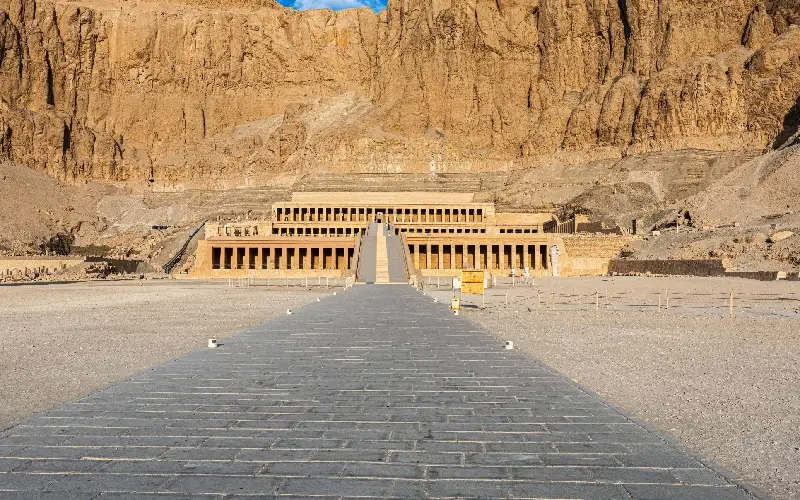
Hatshepsut's mortuary temple stands as one of ancient Egypt's most extraordinary architectural achievements, blending human ingenuity with natural landscape. This masterpiece represents more than architectural brilliance—it embodies a female pharaoh's legitimization strategy through monumental construction. Accordingly, the three-tiered structure served multiple purposes beyond mortuary functions, establishing Hatshepsut's divine right to rule while honoring gods central to Egyptian cosmology.
The temple's innovative design, executed under Senenmut's direction, transformed traditional Egyptian architectural principles. Unlike previous structures, this monument utilized the dramatic cliff backdrop both structurally and symbolically, creating visual harmony between natural and built environments. Additionally, the careful astronomical alignment with Karnak Temple demonstrates ancient Egyptians' sophisticated understanding of celestial movements and their religious significance.
Despite subsequent rulers' attempts to erase Hatshepsut's legacy, particularly Thutmose III's methodical removal of her imagery, the temple survived as a testament to her fifteen-year reign. Afterward, the structure underwent further transformations during the Amarna period and later Christian occupation, each layer adding to its complex historical narrative. Throughout centuries of alteration, the core architectural achievement remained evident.
Modern archeological efforts have undoubtedly revived appreciation for this remarkable monument. The ongoing restoration work since 1961 has revealed the original splendor of Djeser-Djeseru, allowing scholars to better understand both the technical achievements of ancient Egyptian builders and the political circumstances surrounding its creation. The mortuary temple ultimately reflects the cultural, religious and political complexities of Egypt's Eighteenth Dynasty—a physical manifestation of Hatshepsut's unprecedented female kingship during a renaissance period when Egypt reached new heights of prosperity and artistic expression.
The temple incorporates various religious elements, including the sanctuary of Amun, shrines dedicated to Hathor and Anubis, and a solar cult court. It also features depictions of Hatshepsut's divine birth and the expedition to Punt, all of which reinforced her divine right to rule and connection to the gods.
The Mortuary Temple of Hatshepsut is a remarkable three-tiered structure carved into the cliffs of Deir el-Bahari. It blends seamlessly with the natural landscape, featuring innovative architectural design and religious symbolism that served to legitimize Hatshepsut's reign as a female pharaoh.
Senenmut, Hatshepsut's chief steward and loyal advisor, was the brilliant architect behind this monumental project. He served as the overseer of royal works and designed the temple to be grander in scale than its predecessors.
The temple served multiple functions, including housing the royal mortuary cult of Hatshepsut and her father Thutmose I, demonstrating Hatshepsut's legitimacy as pharaoh, and honoring the god Amun-Ra. It was also a site for daily rituals and offerings to the gods.
The temple underwent several transformations throughout history. Thutmose III attempted to erase Hatshepsut's legacy, Akhenaten's reforms led to the removal of Amun imagery, and later, a Christian monastery was established on the upper terrace. Modern excavations and restorations have since revealed its original splendor.
The most famous reliefs depict Hatshepsut’s divine birth and her trading expedition to the Land of Punt. These scenes provide valuable historical and economic insights into ancient Egyptian trade and royal propaganda.































